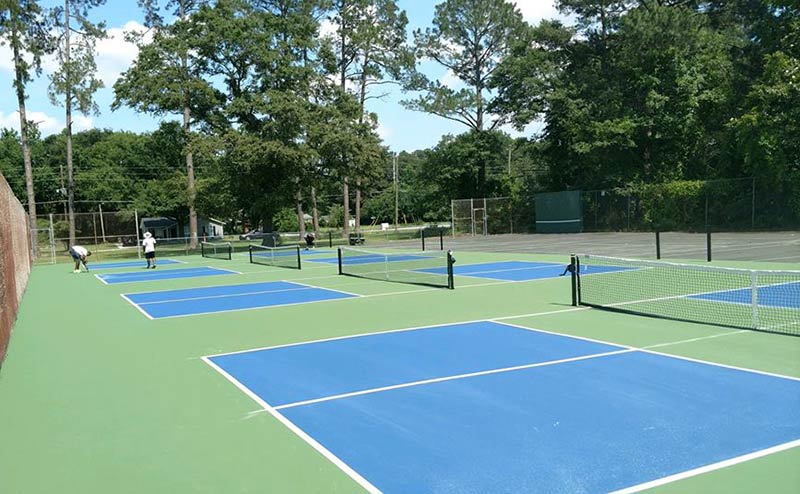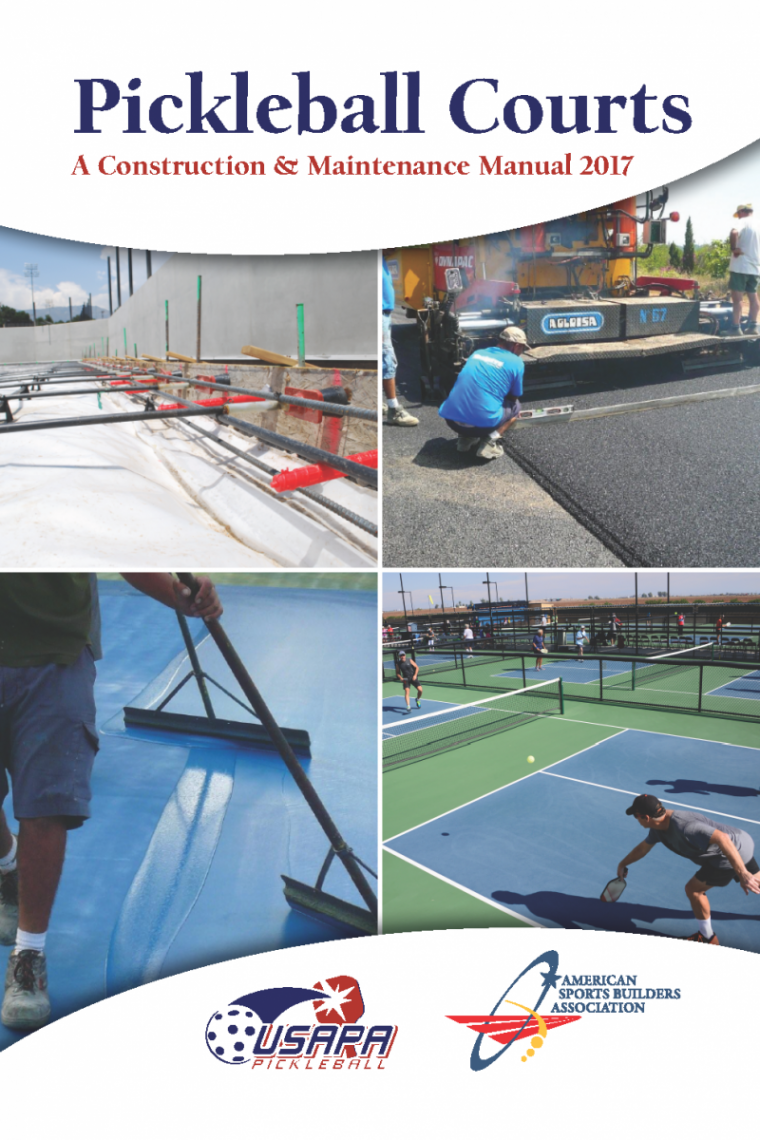A Comprehensive Overview to Creating the Perfect Pickleball Court for All Ability Levels
Designing a pickleball court that accommodates players of differing ability levels demands a diverse method, incorporating crucial components such as court dimensions, surface area products, and availability functions. The balance in between functionality and safety and security is vital, as is the development of a welcoming environment for both viewers and participants. With the right design choices, one can cultivate an appealing atmosphere that advertises pleasure and ability advancement. Pickleball court contractor. The intricacies included in attaining this equilibrium are often ignored. What details factors to consider must be prioritized to ensure a successful implementation?

Comprehending Court Capacities
Understanding the measurements of a pickleball court is crucial for both players and designers, as these specs ensure a consistent and reasonable having fun experience. A typical pickleball court gauges 20 feet large by 44 feet long for both singles and doubles play. The court is divided right into two equivalent halves by a net that stands 36 inches high at the sidelines and 34 inches at the facility.
Secret attributes of the court include the non-volley area, frequently referred to as the "cooking area," which extends 7 feet from the web on both sides. This area is vital for regulating player motion and volleying, making certain calculated play. Additionally, the solution locations on each side of the court are necessary, gauging 10 feet wide and 15 feet deep, created to accommodate appropriate offering techniques.
Surrounding the court, an area of a minimum of 10 feet need to be designated as the security zone, enabling players sufficient room to move and protect against injuries during play. Abiding by these dimensions not just promotes reasonable competitors yet also advertises security and pleasure for all individuals, making it vital for any type of pickleball court style.
Choosing the Right Surface
The option of playing surface for a pickleball court dramatically affects the game's dynamics and player experience. Picking the ideal product is crucial for guaranteeing player performance, safety and security, and comfort. Usual surface areas consist of asphalt, concrete, and specialized sports floor covering.
Asphalt is a prominent choice as a result of its price and toughness. It offers a consistent having fun surface yet can be difficult on joints over expanded play. Concrete, while similar in durability, uses minimal versatility, potentially bring about enhanced effect on gamers' bodies.
For a much more supported experience, numerous facilities choose for specific sporting activities flooring, such as artificial surface areas or modular tiles. These materials often include shock-absorbing buildings, reducing the threat of injuries and enhancing player comfort. Such surface areas can enhance sphere bounce uniformity, which is essential for fair play.
When selecting a surface, consider aspects such as environment, upkeep needs, and the strength of play. A well-chosen surface not just boosts gameplay yet additionally adds to the durability of the court itself. Ultimately, comprehending the nuances of various materials will Clicking Here certainly assist in developing an optimum pickleball atmosphere tailored to numerous skill levels.
Optimum Court Format
An ideal court format is necessary for making the most of both gamer efficiency and viewer pleasure in pickleball. The measurements of a common pickleball court are 20 feet wide by 44 feet long for increases play, maintaining a clear limit that enhances gameplay. The internet, positioned at 36 inches high at the sidelines and 34 inches in the facility, is essential for maintaining the characteristics of the game.
Incorporating marked areas around the court for gamers to relocate freely is crucial. A minimum of 10 feet of clearance on all sides of the court is suggested to avoid collisions and give space for viewers. Furthermore, alignment plays a considerable role; the court needs to ideally be straightened north-south to reduce the influence of sun glow on gamers during height hours.
Clear and noticeable court markings help in gameplay, with contrasting colors for limits and non-volley zones that define critical locations for gamers. Generally, a properly designed court layout fosters an engaging environment for both spectators and players.

Accessibility Factors To Consider
When making a pickleball court, making certain access for all players, consisting of those with handicaps, is critical. A thoughtfully developed court can foster inclusivity and urge involvement from people of varying capabilities.

Accessibility paths to the court have to also be thoroughly prepared. Make certain that paths leading to the court are wide enough for wheelchair customers and are geared up with ramps where required. Signage ought to be clear and big enough to be quickly checked out.
Additionally, seating areas ought to be made to enable very easy accessibility to and from the court. This consists of supplying assigned rooms for viewers who may have mobility obstacles.
Finally, make sure that restroom centers neighboring click for source satisfy ease of access standards. By considering these aspects, you can create a pickleball court that rates and functional for everybody, therefore advertising a vivid and varied area of gamers.
Maintenance and Maintenance
Proper upkeep and maintenance of a pickleball court are vital for making certain optimal playing conditions and extending the life-span of the center. Regular evaluations must be conducted to determine and attend to any type of damages or put on, such as splits in the surface or loosened netting. These problems, if left unattended, can adversely impact gameplay and safety.
Surface upkeep is important; courts ought to be cleansed frequently to get rid of debris, leaves, or dust that can influence traction. For difficult courts, periodic pressure cleaning is advised to maintain surface area stability and appearances. If your court is made from softer products, such as asphalt, resurfacing or sealing might be necessary to secure against weather-related wear.
Additionally, internet elevation and tension ought to be examined routinely, as inappropriate settings can alter gameplay. Keeping surrounding locations, consisting of fence and lighting, is similarly essential for ensuring a satisfying and safe setting.
Conclusion
Finally, the layout of an excellent pickleball court requires a thorough method that incorporates appropriate dimensions, suitable surface products, and thoughtful layout. Pickleball court contractor. Making sure accessibility for all viewers and gamers is important for cultivating an inclusive atmosphere. Regular upkeep is necessary for sustaining court top quality and safety. By adhering to these standards, the best pickleball court can be developed, advertising satisfaction and sports growth for gamers of differing skill degrees.
Designing a pickleball court that provides to players of varying skill degrees necessitates a complex technique, including vital aspects such as court dimensions, surface materials, and ease of access functions.Comprehending you could try these out the measurements of a pickleball court is vital for both players and developers, as these specifications make certain a consistent and reasonable having fun experience.The choice of playing surface for a pickleball court significantly influences the video game's characteristics and player experience.An optimum court layout is crucial for maximizing both player efficiency and spectator pleasure in pickleball. By adhering to these guidelines, the excellent pickleball court can be developed, advertising enjoyment and athletic advancement for players of varying skill degrees.